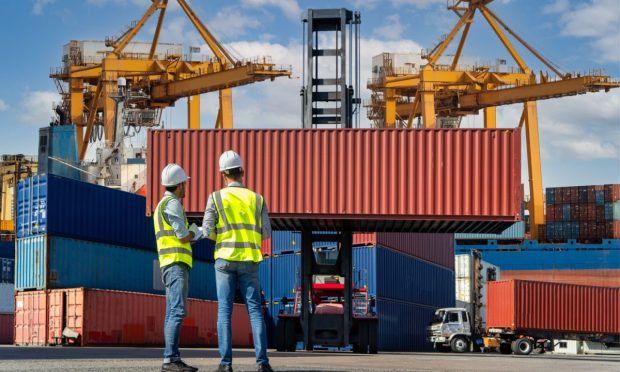Real-Time Insights Bring Clarity to Chaos of Global Logistics Sector

A seismic shift in systemic capability is sweeping across the global shipping ecosystem.
While it’s been more than two years since the Ever Given container ship got stuck in the Suez Canal, the logistics industry still finds itself facing event-driven logjams both large and small on a near-constant basis.
After all, it was just last week (June 11) that a portion of I-95 collapsed in Philadelphia, throwing nationwide trucking routes into disarray.
The speed of technical adoption by the shipping and logistics sector promises, if not to smooth out unavoidable snarls, at least to provide real-time visibility into their impact, while at the same time better priming firms to capture future-fit efficiencies within their inventory cycles and supply chains.
As Will Hansmann, chief technology officer at logistics technology firm project44, told PYMNTS, “the core problems [in global shipping and logistics] are ultimately about order and inventory visibility. What is moving? Where is it moving? What container is it in?”
“The expectation today is that customers will have real-time visibility into where everything is,” Hansmann added.
And asset-level supply chain insights around location and condition, powered by next-generation technologies including Internet of Things (IoT) and other innovations, is increasingly giving firms the predictability they need around previously unknown areas within their asset management and inventory lifecycle processes.
Read also: Shipping Sector Finds Smarter Ways to Operate Using Generative AI
Digitizing Historically Fragmented Supply Chains With Sensor Networks
Today’s global supply chain is plagued by rising costs and long inventory cycles driven by a hostile macro climate, as well as growing scrutiny and awareness of carbon emission risks.
It is also plagued by many legacy problems, including an entrenched and fragmentedly laborious way of doing things.
But at the heart of the sector’s progress is an increasingly connected understanding firms now have over the transit of the goods moving through their supply chains.
The use of IoT devices and other real-time monitoring solutions that connect shippers, suppliers, third-party logistics (3PLs) service providers and ocean providers, while simultaneously linking to the underlying movement of goods, whether that’s on a ship, train or truck, is transforming the efficiencies firms can realize across their logistic processes by giving them first-of-its-kind visibility over historically tangled and opaque operations.
“Everybody’s used to the idea that when you order from Amazon, Amazon’s giving you updates quickly all the time,” Hansmann said.
He explained that expectations within the logistics and shipping sector, as well as the B2B landscape more broadly, are becoming increasingly consumerized as firms see granular, real-time insights as a key value-add and competitive differentiator.
“Ultimately, what businesses want to know as they’re shipping from one continent to another is how do they reduce risk,” he said. “How do they understand the lifecycle of that shipment, and how do they secure it? They want continuous, real-time insight into where everything is and its condition.”
The Connective Tissue of the Global Supply Chain
For years, transformations with cloud computing and the internet have helped businesses organize and disseminate information and spurred the growth of a new, hyper-modern and connected economy.
The offline and highly intermediated nature of shipping and logistics is ripe for data-driven transformations that make the sector a more connected, predictable and even sustainable ecosystem.
“Our initial mission was to look at these historic legacy processes that were highly inefficient, whether they were paper or [electronic data interchange (EDI)] or relatively slow-moving processes, a lot of phone calls, and saying, ‘How do we modernize all of that? How do we bring real-time connectivity to all of these different processes?’” Hansmann said.
That’s why, as he explained, project44 partnered in May with TradeTech solution Nexxiot to provide a comprehensive supply chain intelligence product that integrates Nexxiot’s IoT trackers with project44’s end-to-end visibility platform, bridging data across software and hardware.
Emergent digital tools, including generative artificial intelligence (AI), are also helping to transform the way firms interact within the shipping and logistics sector.
Hansmann said his firm is already integrating generative AI to drive dynamic, conversational interactions for customers using natural language processing (NLP) to provide a low-friction way to surface supply chain insights and intelligence in real time.
As for what the technology leader is looking forward to most?
It’s the constant evolution of the industry, he said.
“There’s a huge number of [application programming interfaces (APIs)] being created by carriers for rating, booking, dispatch, tracking, proof of delivery — all of these things being generated electronically,” he said. “The world is only growing more digitized, connected and efficient.”
For all PYMNTS B2B coverage, subscribe to the daily B2B Newsletter.
